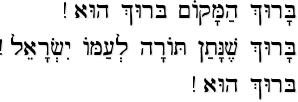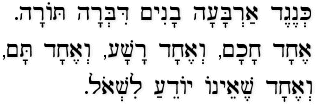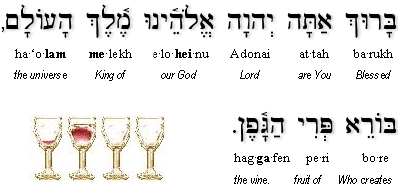|
|
 |
 |
 |
|
Maggid -
|
|
|
|
Telling the Story of Passover
|
|
|
|
 |
 |
|
We cannot eat the Seder meal until the story of Passover is told with joy and gratitude. The Maggid section of the Passover Seder is when we read from our Haggadahs about yetziat mitzraim - the Exodus from Egypt.
|
 |
 |
|
To help get the story going, a young child is usually asked to recite (or to sing) the "Four Questions" about this special evening. The child first recites the opening question regarding the purpose of the Passover Seder:
|
 |
 |
|
He or she then continues with the Four Questions:
|
 |
 |
|
A: We lean on our pillows to remind us that we are now free and no longer live as slaves.
|
 |
 |
 |
|
The Response: Avadim Hayinu
|
|
|
|
The Seder Leader and everyone present replies with the Avadim Hayinu, a combination of Deut 6:21 and Deut 4:34:
|
|
|
 |
 |
|
The sages teach: b'chol dor vador - in each and every generation an individual should look upon him or herself as if he or she (personally) had left Egypt. It's not enough to recall, in some abstract sense, the deliverance of the Jewish people in ancient Egypt, but each Jew is responsible to personally view Passover as a time to commemorate their own personal deliverance from the bondage of Pharaoh. Therefore, the seder leader will call each of us to recite the following in unison:
|
 |
 |
 |
 |
 |
|
 |
 |
 |
|
 |
|
|
v'ilu lo hotzi, hakadosh barukh hu, et-avoteinu mi-mitzraim,
harei anu u'vaneinu uv'nei vaneinu, m'shubadim hayinu le-pharaoh b'mitzraim.
|
|
|
Had the Holy One, blessed be He, not taken out our forefathers from Egypt,
then we, our children, and our children's children would still be enslaved to Pharaoah in Egypt.
|
|
|
 |
|
|
|
Barukh Ha-Makom, barukh hu!
Barukh she-natan Torah le-'amo Yisrael!
Barukh hu!
|
|
|
|
Blessed in the Omnipresent, blessed be He!
Blessed is He who gave the Torah to His people Israel
Blessed be He!
|
|
 |
 |
|
A midrash states that at the time of the great Exodus, only a remnant of 1/5th were actually saved -- while the others died in the maka (plague) of darkness, having fallen so low that they could not believe in the redemption or even want to be redeemed!
As Messianic Jews, we too must recall that the salvation obtained by Seh Elohim hagadol - the great Lamb of God - is not something abstract, but is intensely personal, and were it not for His personal love and sacrifice for us, we likewise would still be enslaved to the "greater Pharaoh" (satan), the god of this world who blinds the eyes of those who do not believe (2 Cor. 4:4).
|
|
|
 |
 |
|
The Parable of the Four Sons
|
|
 |
 |
|
The story of the Four Sons is also read at the Passover seder. Each of the four sons symbolizes a different type of Jew and their relationship with the Torah.
|
 |
 |
|
- The wise son (chakham) inquires about why the Jews practice the customs of Passover. The seder leader describes this son as wise, since he wants to know more about the traditions of his people. The seder is for him!
- The wicked son (rasha') wants no part of the Passover traditions and asks why the Jewish people - other than him - practice the customs of Passover. The seder leader responds by describing this son as wicked, since he thinks Passover customs are meant to be observed by other Jews, but not him. He's a hypocrite.
- The simple son (tam) is somewhat bewildered by the Passover Seder and its rituals. The seder leader responds by admonishing him about God's favor toward the Jews during the time of their slavery in Egypt and why it is important to remember God's salvation with gratitude.
- The son who does not know enough to ask (she'eino yodea lishol) is simply told about the Passover story in accordance with the biblical command: "And thou shalt tell thy son in that day, saying: it is because of that which the Lord did for me when I came forth out of Egypt" (Exodus 13:8). Sadly, most secular Jews today are like this son.
|
 |
 |
|
The story of the Four Sons is intended to commend the wise son and to encourage us to remember the Jewish roots of our faith. We must study Torah and respect the Jewish way of life, for if we neglect this we have failed in our responsibility to our heritage. The wise son understands the importance of his heritage and sees it as a means of preserving the knowledge of the LORD God of Israel for posterity.
|
 |
 |
 |
 |
|
 |
 |
 |
 |
 |
 |
|
 |
|
|
|
Go and Learn - The Story of our Slavery
|
|
|
|
Most Haggadahs will begin the story of our slavery in Egypt by reading from Deut 26:5-8 (from parashat Ki Tisa) which is used a summary statement:
|
|
|
|
 |
|
|
|
 |
|
|
|
|
A wandering Aramean was my father. And he went down into Egypt and sojourned there, few in number, and there he became a nation, great, mighty, and populous. And the Egyptians treated us harshly and humiliated us and laid on us hard labor. Then we cried to the LORD, the God of our fathers, and the LORD heard our voice and saw our affliction, our toil, and our oppression. And the LORD brought us out of Egypt with a mighty hand and an outstretched arm, with great deeds of terror, with signs and wonders.
|
|
 |
 |
|
The seder leader may then (depending on the haggadah selected for use with the seder) go into elaborate detail regarding yetziat Mitzraim - the Exodus from Egypt, beginning with the story of how the Jewish people became slaves in Egypt and their miraculous salvation by the LORD, culminating in the enumeration of the Ten Plagues:
Retell the Story of the Exodus here...
- The Birth of Moses (Exod. 1:1-2:10)
- Moses in Midian (Exod. 2:11-4:17)
- Moses Returns to Egypt (Exod. 4:18-6:12)
- The 10 Plagues (Exod. 6:28-11:10) - see following for extra narrative
- The Blood of the Lambs and the LORD's Passover (Exod. 12:1-30)
- The Exodus from Egypt (Exod. 12:31-13:16)
- Crossing the Sea (Exod. 13:17-15:21)
- From the Sea to Mount Sinai (Exod. 15:22-18-27)
|
 |
 |
|
First we will spill three drops of wine (from our second cup onto a plate) and say:
|
 |
 |
|
Blood and fire and thick smoke...
|
 |
 |
|
As the Haggadah is read, we also spill a drop of wine at the mention of each maka (plague), since the suffering of the Egyptians lessens our joy:
|
 |
|
|
|
#
|
Hebrew
|
Definition
|
|
1
|

|
Dam; blood. Ex 7:14-25
|
|
2
|

|
Tzefardea; frogs; Ex 7:26-8:11
|
|
3
|

|
Kinim; lice; Ex 8:12-15
|
|
4
|

|
Arov; swarms of flies, beetles; Ex 8:16-28
|
|
5
|

|
Dever; sickness (on cattle); Ex 9:1-7
|
|
6
|

|
Shechim; blisters; boils; Ex 9:8-12
|
|
7
|

|
Barad; hail (mixed with fire); Ex 9:13-35
|
|
8
|

|
Arbeh; locusts; Ex 10:1-20
|
|
9
|

|
Choshekh; darkness; Ex 10:21-29
|
|
10
|

|
Makat bechorot; death of the firstborn;
Ex 11:1-12:36
|
|
|
|
 |
 |
|
Note: We do not drink the Second Cup of wine at this time.
After this, we usually sing some verses of the ancient Hebrew song Dayenu ("it would have been enough for us"):
The Hebrew lyrics mean that if He (God) had only brought us out of Egypt it would have been enough. The second verse adds that if He had only given us Shabbat, it would have been enough; the third if He had only given us the Torah, it would have been sufficient. The song goes on and on recounting how the LORD has blessed His people Israel. Here is a transliterated excerpt from the song:
Ilu hotzi, hotzianu
Hotzianu miMitzrayim (2x)
Dayenu.
Chorus:
Dai, dai, yenu (3x)
Dayenu dayenu.
Ilu natan natan lanu
Natan lanu et haShabbat (2x)
Dayenu.
Chorus:
Ilu natan natan lanu
Natan lanu et haTorah (2x)
Dayenu.
|
 |
 |
|
The Second Cup (Deliverance)
|
 |
 |
|
Before we partake of the Second Cup (kos sheini), we must first be sure to explain to everyone present the meaning of the three main elements of the Seder: the Passover Lamb (korban Pesach), the matzah, and the maror.
- Korban Pesach - The sacrifice of the Passover lamb originally commemorated the passing over of those Jews who put their trust in the LORD God of Israel by applying the shed blood of the paschal lamb to their doorposts. Followers of Yeshua the Mashiach believe that He is the true Seh Elohim, the Lamb of God who provides everlasting redemption from slavery - not to Ahavah and Egypt, but to Satan and sin. His sacrifice on the cross is the blood that truly causes the wrath of God to pass over us. (For non-Messianic Jews, the shank bone is used to represent korban Pesach that was offered at the Temple that was destroyed after Yeshua came.)
The Haggadah clearly tells us how the blood of a lamb, placed on the doorposts of every Hebrew dwelling, caused the Angel of Death to "pass over" them. Unlike Rabbinical Judaism, it was not gemillut chasadim (good deeds) which Isaiah called "filthy rags" in the sight of God (Isaiah 64:6), but only the blood of the lamb.
At this time, the Seder Leader lifts up the shank bone from the Seder plate, and we all recite John the Baptist's words:
|
 |
 |
|
- Matzah - The unleavened bread remembers that when the Jews fled Egypt, they had no time to bake their bread. For Messianic Jews, the matzah represents the purity of the body of Yeshua as God's sacrifice. We note the stripes and piercings of the bread of affliction, remembering how Yeshua gave Himself for us.
- Maror - The bitter herbs remembers the life of slavery and how bitter our lives were before the LORD delivered us from bondage. For Messianic Jews, the maror represents the bitterness of our life before we were reborn by the Mashiach.
After discussing the main elements of the Passover Seder, we drink the second cup of wine (the "Cup of Deliverance") and say:
|
|





















